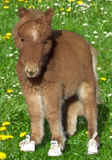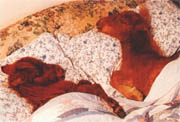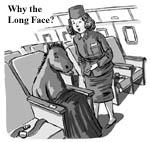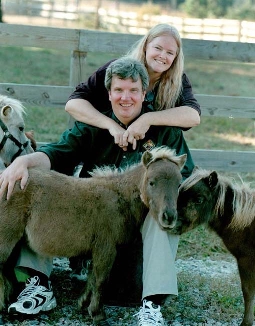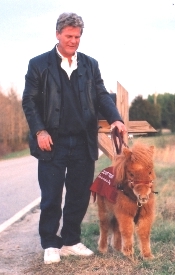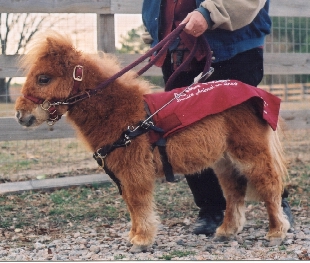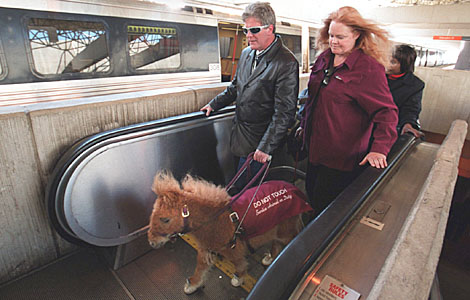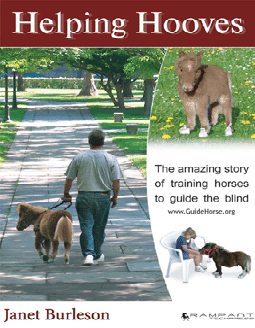|
|
Sun, May 27, 2001
KITTRELL - All of Dan Shaw's tattoos have stories behind them, but the one on his left wrist carries special significance. Shaw, who is part Blackfoot Indian, explains what the symbols mean. The hawk feather stands for "messenger." The eye with a circle around it means "broken eyes." The portrait of a horse represents Cuddles, a miniature horse who will guide him through darkness for many years to come. "It's a tattoo I'm proud of," said Shaw, who has retinitis pigmentosa, a hereditary eye disease marked by a progressive loss of peripheral vision. He came here from his home in Ellsworth, Maine, to train with Janet Burleson and Cuddles, a guide horse for the visually impaired. Burleson and her husband, Don, started the Guide Horse Foundation two years ago. As far as they know, when Cuddles and Shaw "graduate" from their training program this week, Cuddles will be the first official guide horse ever.
A few days ago, Cuddles and Shaw trained in anticipation of the day when they will leave North Carolina together. In the parking lot of a strip mall in Franklinton, he strapped Cuddles into a harness with a padded handle, slipped four white baby shoes on her little feet and tied the laces in bows. The shoes protect Cuddles' feet and prevent her from slipping on slick surfaces. She jumped gracefully from the Burlesons' van and led Shaw for a walk down the sidewalk, weaving around columns and other obstacles. As they approached a pizza parlor, Janet Burleson suggested they go inside for a drink. "Find the door," Shaw said, and Cuddles complied. "That's one thing blind people have trouble with," Don Burleson said. Later she led him down the aisles of a grocery store. "Isn't that just the cutest thing!" one woman said. As Cuddles led him out of the store and back to the sidewalk, Shaw gave her an enthusiastic rub. "Good girl!" Outside, Shaw and Cuddles walked until they reached a curb. Cuddles stopped. "Follow her," Janet Burleson told him. "Let her choose the path." Cuddles steered him to the left, to a cut in the curb. "She always finds the safest route," Shaw said. Since he met Cuddles, Shaw can't seem to stop smiling. The two show affection for each other; he croons to her; she nuzzles him. He can pick her out of a crowd of horses by stroking her tail, which he cut short. "Everybody says she's really pretty," he said. "She's got a good form. I felt her from head to toe." The more he works with her, the more confident he becomes, he said. "It's wonderful. I don't know how to explain the feeling I have inside." The beginnings of a great team More than a year ago, Shaw and his wife, Ann, were working on an application for a guide dog. As the television droned in the background, tuned to an episode of Ripley's Believe It or Not, a segment on a couple in North Carolina who were training miniature horses to guide the blind caught Shaw's attention. "Don't bother filling out that application," he told Ann. "I want a guide horse." Shaw, 45, began losing his sight when he was 17. Over the years, he hid his deteriorating vision until he could do so no longer. "About four years ago, it got real bad," he said. "I needed assistance." He went to the Carroll Center for the Blind near Boston, where he learned to hone his senses of smell, touch and hearing. Experts taught him to use his woodworking tools, which he had shied away from when his vision deteriorated. Woodworking is his hobby and a source of extra income. Shaw runs a bait-and-tackle shop. By the time he heard about guide horses, Shaw's field of vision had shrunk to a pinhole in one eye. He can distinguish between light and dark only if light is shining directly in his face. His two brothers also suffer from retinitis pigmentosa. "I'm the oldest," he said. "My eyes went first." He resisted getting a guide dog for as long as he could because he couldn't bear the thought of eventually losing it. "I'm an animal lover," he said. "I couldn't see getting a dog, loving it, putting my life in the hands of it for eight or 10 years, then putting it down." Miniature horses can live 35 years or more. Shaw knew he wanted one. Half a day of phone calls led the couple to the Burlesons. They care for 29 miniature horses - 10 in training to be guide horses, 13 of their own, three that were rescued and three that belong to the foundation but are not in training - and nine full-size ones on their farm 40 miles north of Raleigh. Janet Burleson is a retired horse trainer, and her husband is a computer consultant. He travels frequently to Manhattan, and when he and his wife ride horses there, they have to navigate several blocks through heavy traffic to reach Central Park. Experts told them, "Drop the reins and let the horse guide you." The advice worked. The horses found their way, and the traffic didn't faze them. When they acquired Twinkie, the smallest of their first four miniature horses, the Burlesons realized that she acted very much like a dog. "She was always so conscious, looking for danger," Don Burleson said. "We wanted to try an experiment, to see if it was practical for her to guide the blind. "Our experiment was a smashing success." Janet Burleson taught Twinkie to respond to voice commands and to lead a blind person around obstacles. But she wasn't agile enough to serve as a guide horse. The Burlesons were trying to raise money to buy more miniature horses to train when the Shaws contacted them. Disappointment set in when they told Dan Shaw that they didn't have a horse for him. But good news came last June, when crime novelist Patricia Cornwell donated $30,000 to the foundation. Cornwell is so taken with the concept of guide horses that she has written one into her next book, Isle of Dogs. Her donation enabled the Burlesons to buy six more miniature horses, including Cuddles. Shaw kept in touch with the Burlesons during Cuddles' training period. On March 6 of this year, the Shaws flew to Raleigh, where they met Cuddles for the first time. "She gave me a little kiss on the face," Shaw said. They walked together, with Cuddles leading and Shaw and Janet Burleson holding her harness. She let go and sent Shaw and Cuddles into a crowded store, where the aisles were jammed with merchandise. She followed behind. "We never bumped into anything the whole time," Shaw said. "That's when I cried." Shaw spent five days training with Cuddles. They flew to Atlanta, where they rode the subway together and navigated moving sidewalks. They began to form a bond that continues to strengthen. Shaw had her image tattooed on his wrist. "She's my guide horse, and I'm sending the message about her," he said. "She is everything I wanted." On his recent visit, Shaw and Cuddles trained on country roads and city streets. They rode elevators and escalators and strolled through restaurants and busy malls. Sirens blared on the streets and trains roared past at a train station. Cuddles never flinched. Wherever they went, people stopped, stared, smiled, asked questions. "You walk into that mall, and the first thing you hear is 'awwwww,'" Shaw said. One person asked him, "Is that half horse, half dog?" Another told him, "It's hard to believe you're blind, the way you walk with her." He doesn't mind the curiosity or the comments. "The more people that know about guide horses, the more help guide horses can get," he said. The Shaws are scheduled to head home, Cuddles in tow, today. On their way home, they will show her off at stops in Washington, New York and Boston. She will be the first horse to go to the top of the Empire State Building, Shaw said, and she will be part of a motorcade in Boston, where she will participate in a fund raiser for the Carroll Center and a graduation party for her and Shaw. When they get back to Maine, Cuddles will meet the Shaws' four children and 12 grandchildren. "They're all waiting for Cuddles, including the town," Shaw said. He plans to take her to city hall, where he will renew his fishing license. An avid fisherman, Shaw hasn't been able to walk to his favorite fishing hole, about a mile from his house, in several years. To find his way, he had to walk with one foot on the road and one foot in the dirt. It wasn't worth the effort, he said. "The first thing Cuddles and me are going to do is go fishing," he said. He also looks forward to visiting the mall with his wife. "He can go his way; I can go my way," Ann Shaw said. "It's nice to know he is safe." When the Shaws left Maine, Ann Shaw told people, "We're going to North Carolina to adopt another little girl." Her husband is so happy, she said, happier than she has seen him in a long time. "I can't believe the thrill that Cuddles has given me," Dan Shaw said. "I feel normal." • Janice Gaston can be reached at 727-7364 or at jgaston@wsjournal.com |
Guides Training Press Photos News Apply FAQ Wishes Contact Home
|
|
Copyright © 1998 - 2005 by the Guide Horse Foundation Inc. Guide Horse ® Guidehorse ® and Helping Hooves ® are registered trademarks. |
The Guide Horse Foundation has the utmost respect for The Seeing Eye® and their seventy-two years of outstanding work with assistance animals for the blind. Even though the press often calls our horses "seeing eye horses", please note that The Guide Horse Foundation is not affiliated with or sanctioned by the Seeing-Eye® or any of the Guide Dog training organizations. Seeing-Eye® is a registered trademark of the Seeing-Eye, Inc.
Birth certificate apostille. Globalapostille.us . высшим образованием
